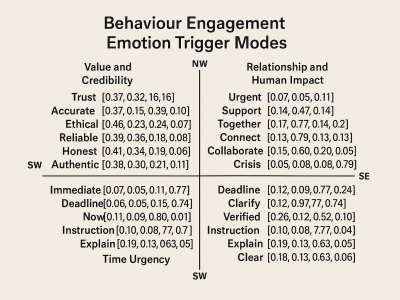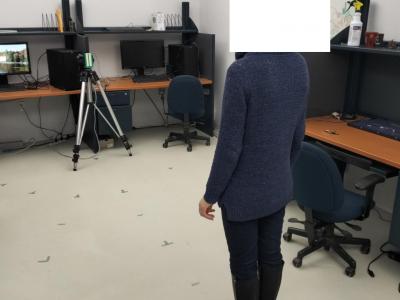Machine Learning
The use of technology in cricket has seen a significant increase in recent years, leading to overlapping computer vision-based research efforts. This study aims to extract front pitch view shots in cricket broadcasts by utilizing deep learning. The front pitch view (FPV) shots include ball delivery by the bowler and the stroke played by the batter. FPV shots are valuable for highlight generation, automatic commentary generation and bowling and batting techniques analysis. We classify each broadcast video frame as FPV and non-FPV using deep-learning models.
- Categories:
 7 Views
7 ViewsThis dataset presents a curated collection of 9,000 English verbs annotated with normalized fuzzy values across four cognitive-behavioral quadrants of the BEET-M (Behavior Engagement Emotion Trigger Modes) model: Value & Credibility (NW), Relationship & Human Impact (NE), Process & Information (SE), and Time Urgency (SW).
- Categories:
 33 Views
33 Views
Droidware is an Android malware dataset developed at the Cybersecurity Lab, GLA University, India. It comprises 253,527 applications, including 129,950 benign and 123,577 malicious samples. The dataset captures 68 features extracted from function call graphs, permissions, and Java source code, providing a comprehensive view of Android malware behavior. This latest and up-to-date dataset supports the training of AI-based malware detection models, aiding in the development of robust malware classification and threat mitigation strategies for cybersecurity research.
- Categories:
 30 Views
30 Views
The Travel Recommendation Dataset is a comprehensive dataset designed for building and evaluating conversational recommendation systems in the travel domain. It includes detailed information about users, destinations, and ratings, enabling researchers and developers to create personalized travel recommendation models. The dataset supports use cases such as personalizing travel recommendations, analyzing user behavior, and training machine learning models for recommendation tasks.
- Categories:
 29 Views
29 Views
The source data files and code files of the paper: optical chaos shift keying communication system via neural network-based signal reconstruction. The following data is included:
1. Source figure file in the paper;
2. Source code of the proposed scheme, include the simulation code for communication, secure analysis and parameter mismatch range.
3. The source Simulink module is included for time-delayed chaotic signal generation.
- Categories:
 28 Views
28 Views
This dataset comprises vibration signals collected from bearing test rigs under both healthy and faulty conditions, designed to support research in fault diagnosis and out-of-distribution (OOD) detection. The data includes:
-
CWRU Dataset: Signals from the Case Western Reserve University bearing test platform, sampled at 12 kHz, covering normal operation and three fault types (inner race, outer race, and rolling element faults) with varying severities (0.007–0.021 inches). OOD samples are explicitly labeled for validation.
- Categories:
 26 Views
26 Views
Paper : Assessment of Inference Improvements for Facial Micronutrient Deficiency Detection using Attention-Enhanced YOLOv5
Authors : Amey Agarwal, Shreya Rathod, Riva Rodrigues, Nirmitee Sarode, Dhananjay R. Kalbande
Desciption
This is a dataset of 7 classes : 6 facial skin problems and 1 null class.
A facial skin problem may be identified in an image and marked using Bounding Box Annotation.
Acne Class indicates deficiency of Vitamin D
Blackhead and Nodules are types of acne
- Categories:
 32 Views
32 Views
This dataset is the original resistance data and gas response data of 11 VOCs in 8 commercial gas sensors collected by the self-developed G919 electronic nose device. Eleven types of VOCs were detected, including acetone, ethanol, butyl acetate, methanol, dimethylbenzene, isopropanol, methylbenzene, benzaldehyde, hexane, n-propanol and ethylene glycol. Eight commercial gas sensors were employed, including MQ-2, MQ-3, MQ-4, MQ-5, MQ-6, MQ-7, MQ-8, MQ-9.
- Categories:
 10 Views
10 Views
This dataset comprises 1301 rounds collected from the 2024 Valorant Champions Tour Pacific and EMEA. Specifically, those rounds contain completed information on Team A and B's number of available ultimate abilities each round, the average number of ultimate points until ultimate ability for each team per round, and each team's total loadout value per round. Each round's outcomes are labeled and weighed against the predicted outcomes in future logistic regression modeling.
- Categories:
 18 Views
18 ViewsThis dataset contains raw FMCW radar signals collected for human localization and activity monitoring in indoor environments. The data was recorded using mmWave radar sensors across two different laboratory settings, designed to simulate real-life scenarios for human detection and localization tasks.
- Categories:
 63 Views
63 Views

